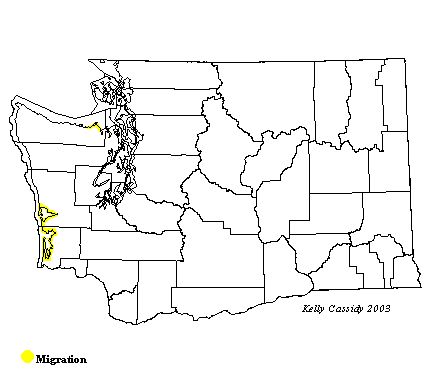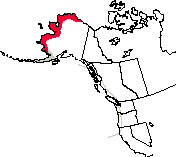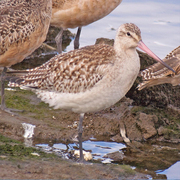Bar-tailed Godwit
General Description
A rare migrant in Washington, the Bar-tailed Godwit is distinctive in its breeding plumage. It has an unstreaked, rufous breast, dark legs, and mottled brown back. The head is lighter rufous and black, and the bill is long with a slight up-curve. In winter plumage, the Bar-tailed Godwit is mottled gray-brown overall. Juveniles and adults in non-breeding plumage can be difficult to distinguish from the more common Marbled Godwit. The Bar-tailed has relatively shorter legs and longer wings than the Marbled, and a very pale whitish lower breast and belly. When the Bar-tailed is standing, the wing-tips extend beyond the tail. The female's bill is longer than the male's. Rarely seen spring birds are typically in breeding plumage, while fall birds are usually in non-breeding plumage. Many are juveniles, especially during the latter part of the migration period.
Habitat
Bar-tailed Godwits nest in rolling tundra with hummocks and low shrubs. During migration and winter, they are found in tidal mudflats along the coast.
Behavior
Range-wide, Bar-tailed Godwits are typically found in large flocks during migration and winter. In Washington, they are usually seen singly or in flocks with Marbled Godwits. They forage by walking slowly and probing deep in the mud with their long, sensitive bills. The female has a longer bill and can forage in deeper water than the male.
Diet
On the breeding grounds, insects are the main diet, supplemented at times with seeds and berries. In coastal areas, Bar-tailed Godwits eat crustaceans, mollusks, worms, and other aquatic invertebrates.
Nesting
Bar-tailed Godwits first breed at the age of two. Males defend territories and attract mates with an aerial display high over their nesting habitat in the tundra. The nest is located on the ground, often on a raised hummock. The nest itself is a shallow scrape lined with grass, moss, and lichen. Both parents help incubate the four eggs for about 21 days. The young leave the nest soon after hatching, and the parents lead them to a marshy area where they find their own food. Both parents tend and protect the young, which fledge at about 30 days.
Migration Status
Bar-tailed Godwits nest across Europe and Asia, and a population has crossed the Bering Strait and nests in Alaska. They are long-distance migrants, wintering from Southeast Asia south to Australia and New Zealand. During migration some birds may wander to the coasts of North America.
Conservation Status
The Canadian Wildlife Service estimates the worldwide Bar-tailed Godwit population at 1,345,000 birds, with 100,000 of those nesting in North America. Reports of this rare visitor have been increasing in Washington, but it is not known if this is a true increase, or a reflection of increased observation. (The number of wintering Marbled Godwits also seems to be increasing.)
When and Where to Find in Washington
A rare visitor, the Bar-tailed Godwit is usually found during migration on the outer coast at places such as Ocean Shores (Grays Harbor County) and Tokeland (Pacific County), or sometimes at Blaine, (Whatcom County), or in the Strait of Juan de Fuca at Dungeness Spit (Clallam County). One was sighted on the mudflats at the Lincoln Street wetlands in Tacoma (Pierce County). The first record was in 1931, and the second wasn't until 1972. Sightings now average about two a year in the Pacific Northwest. Bar-tailed Godwits are more likely to be seen in the fall, and are reported three times as often in this season as in spring. Fall records have ranged from August through October, and spring records from late April through mid-June. A Bar-tailed Godwit wintered at Tokeland in 2001-2002.
 Abundance
Abundance
| Ecoregion | Jan | Feb | Mar | Apr | May | Jun | Jul | Aug | Sep | Oct | Nov | Dec |
|---|---|---|---|---|---|---|---|---|---|---|---|---|
| Oceanic | ||||||||||||
| Pacific Northwest Coast | R | R | R | R | R | R | ||||||
| Puget Trough | ||||||||||||
| North Cascades | ||||||||||||
| West Cascades | ||||||||||||
| East Cascades | ||||||||||||
| Okanogan | ||||||||||||
| Canadian Rockies | ||||||||||||
| Blue Mountains | ||||||||||||
| Columbia Plateau |
Washington Range Map

North American Range Map


Family Members
 Spotted SandpiperActitis macularius
Spotted SandpiperActitis macularius Solitary SandpiperTringa solitaria
Solitary SandpiperTringa solitaria Gray-tailed TattlerTringa brevipes
Gray-tailed TattlerTringa brevipes Wandering TattlerTringa incana
Wandering TattlerTringa incana Greater YellowlegsTringa melanoleuca
Greater YellowlegsTringa melanoleuca WilletTringa semipalmata
WilletTringa semipalmata Lesser YellowlegsTringa flavipes
Lesser YellowlegsTringa flavipes Upland SandpiperBartramia longicauda
Upland SandpiperBartramia longicauda Little CurlewNumenius minutus
Little CurlewNumenius minutus WhimbrelNumenius phaeopus
WhimbrelNumenius phaeopus Bristle-thighed CurlewNumenius tahitiensis
Bristle-thighed CurlewNumenius tahitiensis Long-billed CurlewNumenius americanus
Long-billed CurlewNumenius americanus Hudsonian GodwitLimosa haemastica
Hudsonian GodwitLimosa haemastica Bar-tailed GodwitLimosa lapponica
Bar-tailed GodwitLimosa lapponica Marbled GodwitLimosa fedoa
Marbled GodwitLimosa fedoa Ruddy TurnstoneArenaria interpres
Ruddy TurnstoneArenaria interpres Black TurnstoneArenaria melanocephala
Black TurnstoneArenaria melanocephala SurfbirdAphriza virgata
SurfbirdAphriza virgata Great KnotCalidris tenuirostris
Great KnotCalidris tenuirostris Red KnotCalidris canutus
Red KnotCalidris canutus SanderlingCalidris alba
SanderlingCalidris alba Semipalmated SandpiperCalidris pusilla
Semipalmated SandpiperCalidris pusilla Western SandpiperCalidris mauri
Western SandpiperCalidris mauri Red-necked StintCalidris ruficollis
Red-necked StintCalidris ruficollis Little StintCalidris minuta
Little StintCalidris minuta Temminck's StintCalidris temminckii
Temminck's StintCalidris temminckii Least SandpiperCalidris minutilla
Least SandpiperCalidris minutilla White-rumped SandpiperCalidris fuscicollis
White-rumped SandpiperCalidris fuscicollis Baird's SandpiperCalidris bairdii
Baird's SandpiperCalidris bairdii Pectoral SandpiperCalidris melanotos
Pectoral SandpiperCalidris melanotos Sharp-tailed SandpiperCalidris acuminata
Sharp-tailed SandpiperCalidris acuminata Rock SandpiperCalidris ptilocnemis
Rock SandpiperCalidris ptilocnemis DunlinCalidris alpina
DunlinCalidris alpina Curlew SandpiperCalidris ferruginea
Curlew SandpiperCalidris ferruginea Stilt SandpiperCalidris himantopus
Stilt SandpiperCalidris himantopus Buff-breasted SandpiperTryngites subruficollis
Buff-breasted SandpiperTryngites subruficollis RuffPhilomachus pugnax
RuffPhilomachus pugnax Short-billed DowitcherLimnodromus griseus
Short-billed DowitcherLimnodromus griseus Long-billed DowitcherLimnodromus scolopaceus
Long-billed DowitcherLimnodromus scolopaceus Jack SnipeLymnocryptes minimus
Jack SnipeLymnocryptes minimus Wilson's SnipeGallinago delicata
Wilson's SnipeGallinago delicata Wilson's PhalaropePhalaropus tricolor
Wilson's PhalaropePhalaropus tricolor Red-necked PhalaropePhalaropus lobatus
Red-necked PhalaropePhalaropus lobatus Red PhalaropePhalaropus fulicarius
Red PhalaropePhalaropus fulicarius

